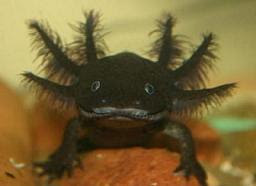The axolotl (Ambystoma mexicanum) is the  best-known of the Mexican neotenic mole salamanders belonging to the Tiger Salamander complex. Larvae of this species fail to undergo metamorphosis, so the adults remain aquatic and gilled. The species originates from the lake underlying Mexico City and are also called ajolote (which is also the common name for Mexican Mole Lizards).
best-known of the Mexican neotenic mole salamanders belonging to the Tiger Salamander complex. Larvae of this species fail to undergo metamorphosis, so the adults remain aquatic and gilled. The species originates from the lake underlying Mexico City and are also called ajolote (which is also the common name for Mexican Mole Lizards).
Axolotls are used extensively in scientific research due to their ability to regenerate most body parts, ease of breeding, and large embryos. They are commonly kept as pets in the United States, Great Britain (under the spelling axlotl), Australia, Japan and other countries.
Axolotls should not be confused with waterdogs, the larval stage of the closely related Tiger Salamanders (Ambystoma tigrinum and Ambystoma mavortium), which is widespread in much of North America which also occasionally become neotenic, nor with mudpuppies (Necturus spp.), fully-aquatic salamanders which are unrelated to the axolotl but which bear a superficial resemblance.
As of 2008, axolotls are near extinction, due to urbanization in Mexico City, and polluted waters. Nonnative fish have also recently been introduced to the waters. These new fish have been eating the axolotls' babies, as well as its primary source of food. The axolotl is currently on the International Union for Conservation of Nature's annual Red List of threatened species.
Description:
A sexually-mature adult axolotl, at age 18-24 months, ranges in length from 15–45 centimetres (5.9–18 in), although a size close to 23 centimetres (9.1 in) is most common and greater than 30 centimetres (12 in) is rare. Axolotls possess features typical of salamander larvae, including external gills and a caudal fin extending from behind the head to the vent.
Their heads are wide, and their eyes are lidless. Their limbs are underdeveloped and possess long, thin digits. Males are identified by their swollen cloacae lined with papillae, while females are noticeable for their wider bodies full of eggs. Three pairs of external gill stalks (rami) originate behind their heads and are used to move oxygenated water.
The external gill rami are lined with filaments (fimbriae) to increase surface area for gas exchange. Four gill slits lined with gill rakers are hidden underneath the external gills. Axolotls have barely visible vestigial teeth which would have developed during metamorphosis. The primary method of feeding is by suction, during which their rakers interlock to close the gill slits. External gills are used for respiration, although buccal pumping (gulping air from the surface) may also be used in order to provide oxygen to their lungs.
Axolotls have four different colours, two naturally occurring colours and two mutants. The two naturally occurring colours are wildtype (Varying shades of brown usually with spots) and melanoid (black). The two mutant colours are leucistic (pale pink with black eyes) and albino (golden, tan or pale pink with pink eyes).via
Other pictures of Axolotl.
Video of Axolotl.
 Grab our feeds now!
Grab our feeds now!



No comments:
Post a Comment